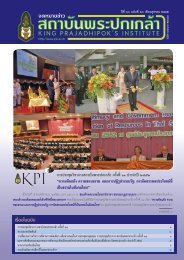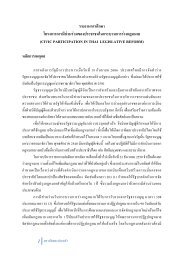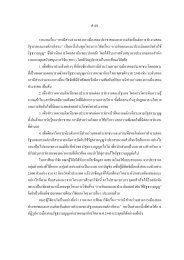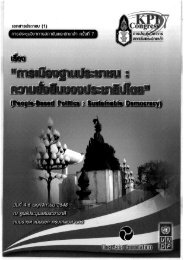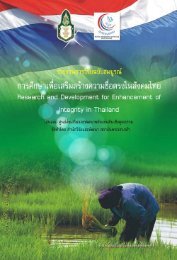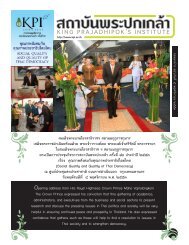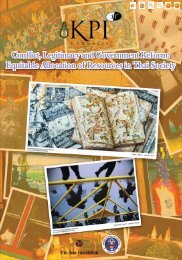SUFFiciENcy EcONOMy ANd GRASSROOtS DEvElOPMENt
SUFFiciENcy EcONOMy ANd GRASSROOtS DEvElOPMENt
SUFFiciENcy EcONOMy ANd GRASSROOtS DEvElOPMENt
Create successful ePaper yourself
Turn your PDF publications into a flip-book with our unique Google optimized e-Paper software.
198<br />
The Meaning of Sufficiency Economy <br />
International Conference<br />
to survive, they needed to change cash crop plantation into planting food crops to<br />
serve families needs. Meanwhile, the deforestation continues to be a very critical<br />
issue. In the villagers’ perspective, the forest is the main source of food and<br />
household commodities. They found that food gathering from the forest was getting<br />
harder to locate, and also the reduced rainfall as an indicator of the depleted forests.<br />
In order to address such problems, an active group of thirteen farmers was formed to<br />
take action according to the concept of sufficiency. After a while, they formed a<br />
more extensive network by introducing friends and relatives to Inpaeng ideas. In<br />
1988, they bought a piece of land and built Inpaengcentre as a place for the<br />
network’s activities. From that time onwards, more and more people were attracted<br />
to the idea of economic self-sufficiency. In 2009, Inpaeng members increased to<br />
almost 30,000 people located in four provinces around the Phuphan mountain range.<br />
Inpaeng’s concepts and missions<br />
As noted in the Inpaeng 2002-2003 annual report accompanied with some<br />
articles on Inpaeng network(เครือข่ายอินแปง 2005; รัตนา โตสกุล et al. 2548; เสรี พงศ์พิศ<br />
2545), the main concepts can be summarized as follows.<br />
Firstly, regarding the concept of reflection, members were asked to look back<br />
to the past, compare their quality of life to the present, and project the future<br />
situation. As a result of several conversations and meetings, it was seen that their<br />
quality of life at the present time was diminishing compared to the past and the trend<br />
looked like it would get worse in the future. In the near future, they predicted more<br />
serious droughts, lower product prices, more farm chemical use, more debts, worse<br />
physical health due to chemical exposure, and more family stress due to emigration<br />
for better jobs. <br />
Secondly, with respect to the concept of community strength, Inpaeng<br />
members were encouraged to explore their communities’ strengths. The strengths<br />
could be identified in several forms such as community norm, natural resources,<br />
community setting, local wisdom and the presence of local scholars. Inpaeng’s<br />
believed that by focusing on communities’ strengths, not on problems the members<br />
could design their sufficiency lifestyle better.<br />
Thirdly, with the concept of evidence-based decision making, community<br />
research skills were introduced to the members. Inpaeng networks encouraged their<br />
members to analyse their annual food intake and household consumption. Local<br />
research, exploring community food consumption, was carried out. They found that<br />
most of the food consumed in the community could be produced by the people in the<br />
community. Then they were encouraged to change from monoculture cash cropping<br />
such as cassava, sugarcane, or eucalyptus forests to the mixed, varied, integrated<br />
farming systems. This concept of evidence-based decision making can be considered<br />
as the counterpart of the “blind follower” concept. People generally make decisions,<br />
particularly farming decisions, following neighbors’ or government suggestions<br />
without adequate understanding to make their own decisions. For example, when<br />
cassava’s price is rising, everyone changes their paddy field to cassava planting or



